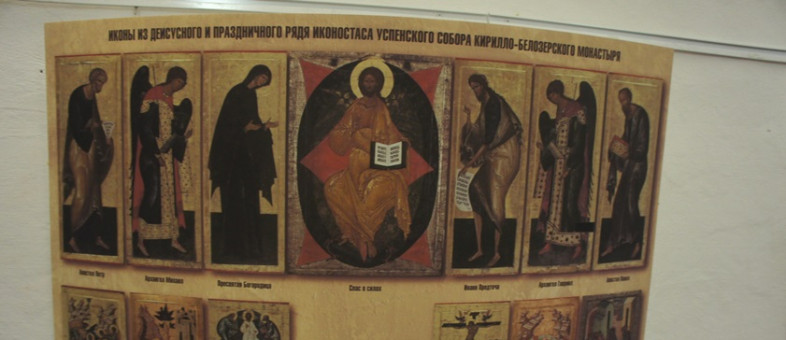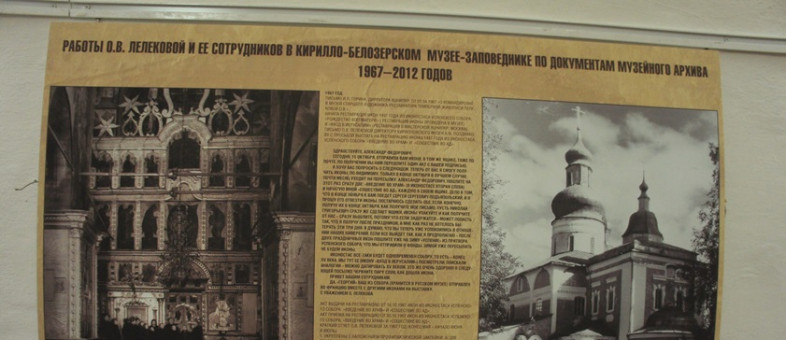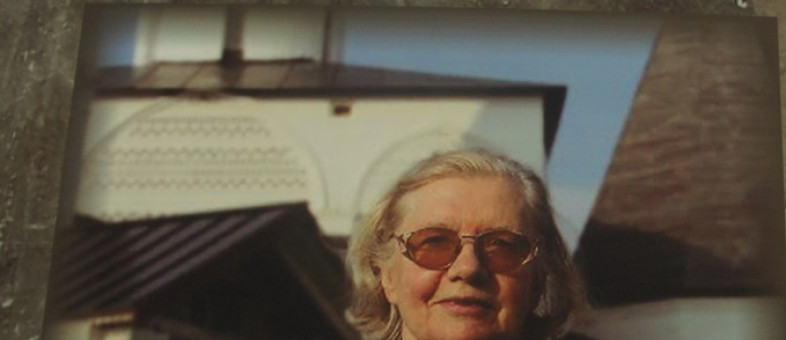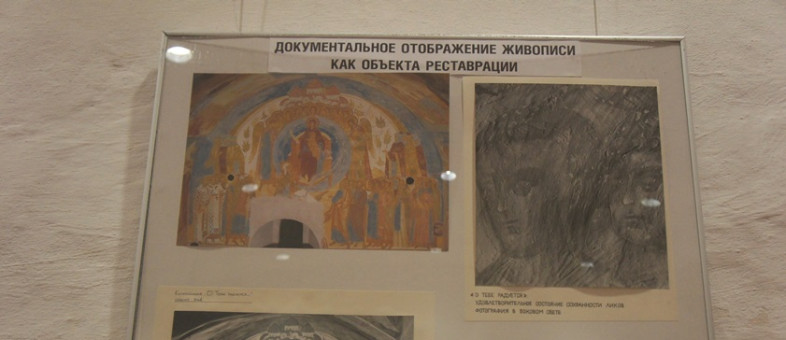Masters of revival. Best restorers’ works – in Kirillo-Belozersky Museum-Reserve!
The exhibition “Preservation of Old Russian Painting. 50th Anniversary of Collaboration with State Research Institute for Restoration” was opened in the conference hall of the Kirillo-Belozersky Museum-Reserve. It tells about the works of the outstanding Russian restorers of medieval painting, those people who have restored the frescoes of Dionisy in the Ferapontov Monastery and other invaluable monuments of Old Russian art.
The museum has been cooperating with the State Research Institute for Restoration since the 1970s. You can hardly find a church in the Kirillo-Belozersky Museum-Reserve where the employees of the institute have never worked.
O.V. Lelekova, E.M. Kristi, V.V. Baranov, N.L. Rebrikova, N.G. Bregman, V.S. Dedukhina, A.N. Agarkov, D.S. Golovkova and other restorers worked at the museum in different years.
Nikolay Georgievich Bregman continues carrying out restoration in the Kirillo-Belozersky Museum-Reserve up to now. He is the leading expert of the department in the State Research Institute for Restoration, the restorer of the highest category, a member of the attestation commissions on easel and tempera painting and decorative and applied arts, a member of the restoration council in the Ministry of Culture of the RF. He remembers that their pleiad of restorers worked on site without removing icons from the churches, “Because it was quite often when the works of Old Russian art were not just brought back after their restoration”.
The experts of the State Research Institute for Restoration worked on a lot of iconostases. The exhibition in the conference hall of the Kirillo-Belozersky Museum-Reserve gives a chance to judge how difficult and unique this process was.
The specialists of the State Research Institute for Restoration were entrusted with the most valuable articles. For instance, in the late 1990s, they were commissioned to restore Dionisy’s frescoes of 1502 in the Nativity of the Virgin Cathedral (the Museum of Dionisy’s Frescoes). This wall-painting is among the main achievements of Old Russian culture. They elaborated and almost implemented the method of restoration and conservation with some gentle cleaning of the surface of the paint layer as a result of complex research of the institute and application of the principles of easel painting restoration for the monument with the unique monumental painting.
The research and elaboration of the conservation method lasted for 3 years. The paint layer was examined from the scaffolding with the help of an operational stereoscopic microscope. They found out that the paint layer condition was critical because of chalking. Such an approach to the determination of the preservation of the paint layer of Dionisy’s frescoes turned out to be wrong because chalking was the first indication of tempera painting on the wall that the creators of the frescoes in Ferapontovo concluded their work with. The experts strengthened only some sections that were damaged where the paint layer lost its bond with the gesso and its surface was destroyed to an appreciable depth.
The State Prize of the Russian Federation in 1998 given to the employees of the institute for the restoration of Dionisy’s frescoes evidences the highest level of the work done in the Museum of Dionisy’s Frescoes.
Such appreciation was not a fluke – when a real professional tackles the problem, the result will be always successful. The restoration work in Ferapontovo was headed by Olga Vladimirovna Lelekova – the restorer whose professional life numbered several decades!
“The heritage of Olga Vladimirovna Lelekova is great!” underlined M.N. Sharomazov, director of the Kirillo-Belozersky Museum-Reserve. “Her achievements are obvious and widely recognized, first of all, regarding preservation of the monuments of Old Russian painting of global importance. Two central projects of O.V. Lelekova in which she participated both as a head and a restorer were restoration and preservation of the frescoes painted by Dionisy in 1502 in the Nativity of the Virgin Cathedral of the Ferapontov Monastery (the UNESCO World Heritage Site since 2000) and the package of work on the iconostasis of the Assumption (Dormition) Cathedral in the Kirillo-Belozersky Monastery (1497). To restore the unique cycle of the frescoes in Ferapontovo, they had to study the technique and materials of Dionisy at the preparatory stage of conservation. The scientific method of Olga Lelekova gave a chance to achieve impressive results during the restoration process. The team consisting of 8 participants of this project was awarded the State Prizes of the Russian Federation in 1998.
Working on the iconostasis of the Assumption (Dormition) Cathedral, they did not only restore, but also carried out a complex of various restoration activities (including painting of copies of the Deisis and the feast tiers of the iconostasis). The longstanding work resulted in the preservation of the very important monument and the publication of the monumental two-volume book that described the results of its research in detail.
The longstanding work with medieval monuments of the Russian North was only a part of restoration and scientific activity of O.V. Lelekova. Being a restorer with unique experience and knowledge, she worked together with other specialists in various cities of Russia and foreign countries: the Philippines, Finland, Germany, and France. Her works were actively published. Olga Lelekova worked on different issues of study of medieval painting and restoration. She took part in plenty of international conferences (in Germany, Holland, Lebanon, France, Serbia, Bulgaria, Greece, Belgium); was an author of about 100 works, a visiting expert in the leading museums of the world, for example, the Louvre. Her author’s technologies of practical restoration wait for their successors who could use experience and achievements of O.V. Lelekova for preservation of ancient works of art both in Russia and abroad”.
Visiting the exhibition “Preservation of Old Russian Painting. 50th Anniversary of Collaboration with State Research Institute for Restoration”, you will be able to see not just photos of the icons that have been restored in different years, but to learn about some aspects of modern approaches to preservation of the artistic and cultural heritage of Old Russian masters.
The display in the conference hall of the Kirillo-Belozersky Museum-Reserve presents photo materials about the history of research and conservation of Dionisy’s frescoes; traditional documentation obligatory for restoration of monuments and new forms used during restoration: close-up photography, microphotography of the paint layer that gives an idea of the masters’ palette, up-to-date forms of colour digital photography, large-scale reproduction of some fragments of painting that a usual visitor cannot see.
Visiting the exhibition “Preservation of Old Russian Painting. 50th Anniversary of Collaboration with State Research Institute for Restoration”, you will be able to see photo materials about the history of research and conservation of Dionisy’s frescoes and to learn about new forms used during restoration: close-up photography, microphotography of the paint layer that gives an idea of the masters’ palette, up-to-date forms of colour digital photography.
Official name of the museum:
The Federal State Budgetary Institution of Culture “Kirillo-Belozersky Historical, Architectural and Art Museum-Reserve”
Founded:
In 1924
Museum status:
It was included into the State List of Particularly Valuable Objects of Cultural Heritage of the Peoples of the Russian Federation in 1997.

 найти на плане
найти на плане






